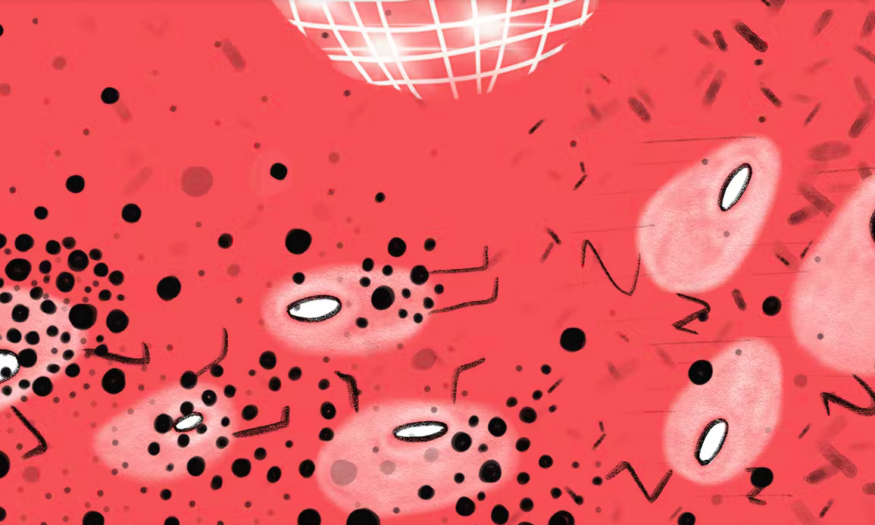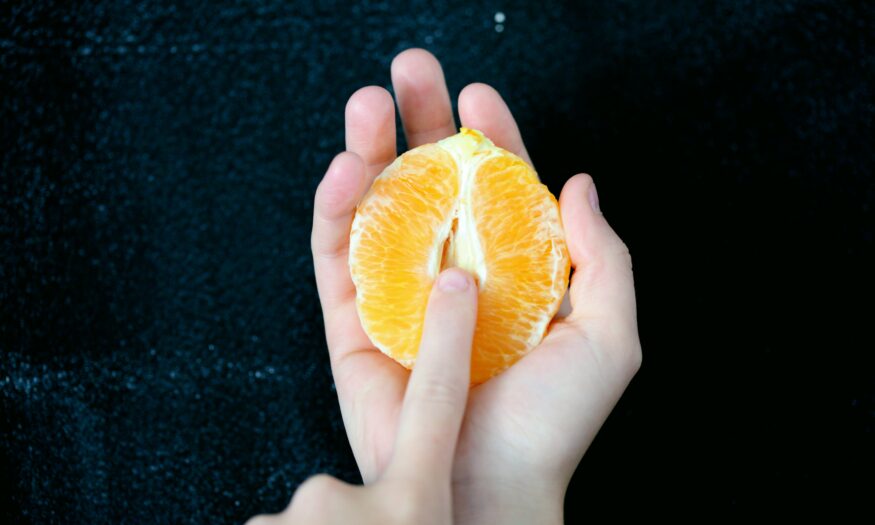Pussy Wetness and Discharge

-
Topics Include:
Arousal
Cervical Mucus
Discharge
Lubricant
Menstruation (Periods)
Vagina
Vaginal Sex
The following text uses the word “pussy*” as defined by Pussypedia.
by Kimberly Rubin
What’s going on?
The typical narrative surrounding sexual excitement is that your pussy* “gets wet” as you get turned on. However, that can lead to a fundamental misunderstanding of the pussy*, as well as some awkward moments when you realize your pussy* is wet at seemingly random times or your underwear displays a sticky, sometimes colored fluid.
Not to fret! These moments are normal for people with pussies*! The vagina is lined with membranes that produce moisture and mucus, meaning there is always some level of wetness inside. This moisture may be indicative of fertility, sexual arousal, or infection. And the discharge is often the vagina’s way of cleaning itself out.1 Understanding kinds of discharge can help us understand the cycles and health of our pussies*.
There are three main types of pussy* fluid: cervical fluid, lubrication, and infection-caused fluid:
1. Cervical fluid
Cervical fluid, or cervical mucus, is created and secreted from the membranes of the cervix.2 As Gynecologist Elizabeth Buescher explained for AllDischarge.com, the amount and type of mucus changes in relation to the body’s production of estrogen. Therefore, as more estrogen is produced when the body is more fertile, and more estrogen means more mucus, observing the amount and type of mucus can allow you to track your body’s fertility cycle. The mucus aids sperm in passing through the cervix and into the uterus and Fallopian tubes for fertilization and impregnation.3 Ovulation can lead to the pussy* producing up to 30 times more mucus, hitting its peak the day before or the day the ovum is released. Cervical fluid may also continue throughout pregnancy.4
Every pussy* produces mucus in different amounts and varieties, so the exact type of mucus will vary from pussy* to pussy*. However, there are some general rules of thumb. First, healthy cervical mucus can smell strong, but should not be overwhelming (we’re not sure what the line is either, but know that some smell is normal) or foul-smelling.5 Second, you can expect the following types of mucus for each stage of the body’s menstrual cycle:
- Before ovulation: thick, white mucus3
- At ovulation: sticky, stringy mucus3
- Before menstruation: thick, yellowish mucus3
- During menstruation: creamy or clear, smooth mucus3
- Toward the end of menstruation: pink or brown, watery mucus (as the pussy* discharges the remaining blood from the uterus)5
2. Lubrication
Pussy* lubrication is also linked to the body’s hormones—estrogen, progesterone, and testosterone.6 The pussy* produces fluid in two types of glands: the Bartholin’s, located on either side of the vaginal opening and the Skene’s, located on either side of the urethra. Lubrication aids in pleasure during sexual activity. The glands continue to produce fluid for a few hours after sex, leading to increased discharge.
3. Infection
Pussy* discharge may also be the product of infection.7 An unexpected increase in the amount of discharge, or a change in the smell or color of discharge, may be a sign that something is not right in the pussy*.6,3 Common examples include:6,3
- Yeast Infection: thick, white or yellowish mucus with a texture of cottage cheese
- Chlamydia & Trichomoniasis: yellow, pink, or gray mucus with a foul smell
- Bacterial Vaginosis: creamy white or grayish mucus with a fishy smell7
How can I take care of my pussy*?
Generally, the best way to take care of your pussy* is to get to know it! While the descriptions above can give a sense of how a pussy* typically produces fluid and discharge, every pussy* is unique. Understanding how your pussy* feels throughout your cycle, and what types and amounts of discharge are produced will enable you to know what discharge is normal and what discharge may be the indication of something else.
This also means getting to know how your pussy* typically responds to sexual stimulation. Every pussy* varies in how much lubrication it produces.8 Changes in lubrication may be caused by several things:
Hormonal Changes: the reduction in estrogen and progesterone associated with perimenopause can result in less lubrication.9 Drugs that alter your hormonal levels, including hormonal birth control, may have a similar effect.6
Medications: certain drugs may also interfere with natural lubrication, including antihistamines such as Benadryl.10 These drugs are designed to dry out mucus membranes elsewhere in the body, but have a similar effect on the vagina, according to Gynecologist Alyssa Dweck.8
Dehydration: less moisture in the body, less moisture in the pussy* – makes sense, right?9
Arousal: There should be no shame if your pussy* isn’t “wet enough.” A lack of lubrication may or may not also mean that you are not fully aroused.11 If you are getting freaky by yourself or with a partner, do things to get turned on. Jumping straight into penetration without warming up first can be uncomfortable or just not that pleasurable. Also, lube is always a great option to supplement your pussy*’s natural lubrication and aid in sexual activity. A 2011 study found that use of artificial lubrication in sexual activity alone or with a partner resulted in reports of increased sexual pleasure and sexual satisfaction.12 You should spend some time testing the different kinds in order to find which works best for your pussy*. Also, be sure to follow safer sex methods with your lube. 😉
Sources
1. OBOS Common Medical Conditions Contributors. “Vaginal Infections.” Our Bodies Ourselves. (2011).
2. OBOS Anatomy & Menstruation Contributors. “Self-Exam: The Cervix Close-Up.” Our Bodies Ourselves. (2014).
3. Buescher, Elizabeth. “What is Cervical Mucus before Period like?” All About Vaginal Discharge. Accessed 2018.
4. Buescher, Elizabeth. “Clear Watery Discharge: When Does It Occur & Why?” All About Vaginal Discharge. Accessed 2018.
5. Buescher, Elizabeth. “Must-Knows About Watery Discharge Before and After Period.” All About Vaginal Discharge. Accessed 2018.
6. OBOS Sexuality & Relationships Contributors. “Hormones that Affect Sexual Desire.” Our Bodies Ourselves. (2015).
7. OBOS Common Medical Conditions Contributors. “Bacterial Vaginosis.” Our Bodies Ourselves. (2011).
8. OBOS Sexuality & Relationships Contributors, “How to Choose a Lubricant for Pleasure and Safety.” Our Bodies Ourselves. (2014).
9. OBOS Menopause Contributors. “Dealing with Vaginal Dryness.” Our Bodies Ourselves. (2014).
10. OBOS Sexuality & Relationships Contributors, “Medications That Can Affect Sexual Desire and Pleasure.” Our Bodies Ourselves. (2014).
11. Feinn, Lily. “How Allergy Medication Can Affect Your Sex Life.” Bustle. (2016).
12. Herbenick D, Reece M, Hensel D, Sanders S, Jozkowski K, and Fortenberry JD. “Association of Lubricant Use with Women’s Sexual Pleasure, Sexual Satisfaction, and Genital Symptoms: A Prospective Daily Diary Study.” Journal of Sexual Medicine. 8. (2011): 202-212.
This article was previously published in Pussypedia and is reposted with permission.






